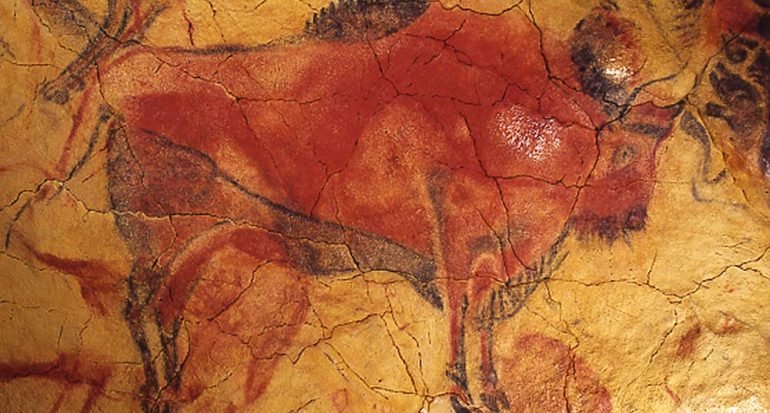1. The Paleolithic Period (c.2500000 - 10000 BC)
• Paleolithic means “old stone age.” This is te beginning of human history.
• The Paleolithic is by far the longest period of humanity's time, about 99% of human history. So it was a very very long period.
• People moved around to find animals or animal products (eggs) and plants (fruits, leaves, roots...) to eat. They were hunter-gatherers.
• They were nomads. It means that housing was temporary and they moved from one place into another looking for places that fitted their necesites. First they lived in caves and later they used simple materials to build tiny huts.
• They used simple materials like stone, bone and wood to make human's first tools.
• Later in time people learned to use fire.
2. The Mesolithic Period (c.10000 - 5500 BC)
• Mesolithic means “middle stone age.” It is the transition period between the Paleolithic and the Neolithic. It was a gradual process.
• During this period we saw the development of finer, smaller stone tools such as arrows or spear heads. Stone tools not only cut, but also polished.
• The first evidence for "homes" in many European places comes from this period.
• The first canoes or simple boats were made also during this period. This meant that humans started to fish and hunt.
• The dog was also domesticated during this period, probably by the breeding of the least aggressive wolves.
3. The Neolithic Period (c.5500 - 2500 BC)
• Neolithic means “new stone age.” It is the beginning of sedentary life for humans.
• This Era saw the beginnings of agriculture. People became farmers. They cultivated crops and domesticated animals.
• Villages were formed near sources of water.
• Animals such as cows and sheep were domesticated and provided peoples with meat, milk, wool, leather and bone.
• Farming tools were made of stone and also of wood, leather and bone, as animals had been domesticated.
• People started to make pottery for storage.
____________________
La Edad de Piedra se divide en periodos paleolíticos, mesolíticos y neolíticos.
1. El período paleolítico (c.2500000 - 10000 AC)
• Paleolítico significa "edad de piedra". Este es el comienzo de la historia humana.
• El Paleolítico es, con mucho, el período más largo del tiempo de la humanidad, aproximadamente el 99% de la historia humana. Fue un período muy muy largo.
• La gente se movía para encontrar animales o productos de origen animal (huevos) y plantas (frutas, hojas, raíces ...) para comer. Eran cazadores-recolectores.
• Eran nómadas. Significa que la vivienda era temporal y se trasladaban de un lugar a otro en busca de lugares que se ajustaran a sus necesidades. Primero vivieron en cuevas y luego usaron materiales simples para construir pequeñas chozas.
• Utilizaban materiales simples como piedra, hueso y madera para hacer las primeras herramientas humanas.
• Más tarde, la gente aprendió a usar el fuego.
2. El período mesolítico (c.10000 - 5500 AC)
• Mesolítico significa "la edad de piedra media". Es el período de transición entre el paleolítico y el neolítico. Fue un proceso gradual.
• Durante este período vimos el desarrollo de herramientas de piedra más pequeñas y finas, como flechas o puntas de lanza. Las herramientas de piedra no solo cortan, sino que también se pulen.
• La primera evidencia de "hogares" en muchos lugares europeos proviene de este período.
• Las primeras canoas o botes simples también se hicieron durante este período. Esto significaba que los humanos comenzaron a pescar y cazar.
• El perro también fue domesticado durante este período, probablemente por la cría de los lobos menos agresivos.
3. El período neolítico (c.5500 - 2500 AC)
• Neolítico significa "nueva edad de piedra". Es el comienzo de la vida sedentaria para los humanos.
• Esta era vio los inicios de la agricultura. Las personas se convirtieron en granjeros. Cultivaban plantas y domesticaron animales.
• Se formaron aldeas cerca de las fuentes de agua.
• Los animales como las vacas y las ovejas fueron domesticados y proporcionaron a los pueblos carne, leche, lana, cuero y huesos.
• Las herramientas agrícolas estaban hechas de piedra y también de madera, cuero y hueso, ya que los animales habían sido domesticados.
• La gente comenzó a hacer cerámica para el almacenamiento.
¡Disfruta de los videos sobre el paleolítico y el neolítico!

Imagen de la pintura rupestre de un Bisonte Macho Erguido en Las Cuevas de Altamira
No hay comentarios:
Publicar un comentario